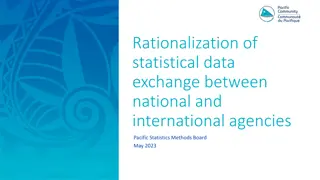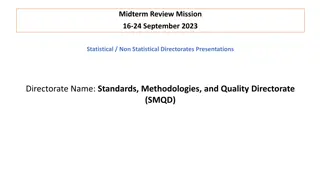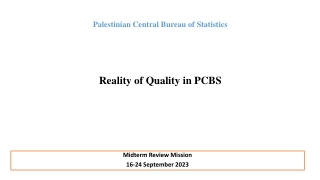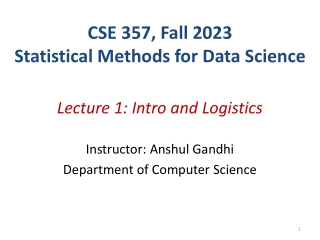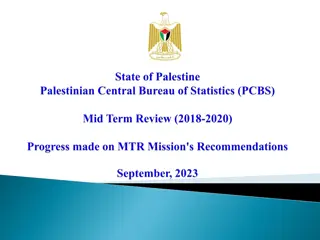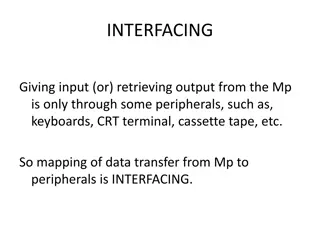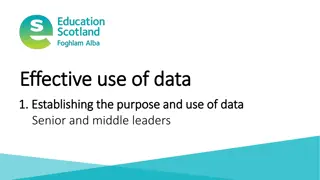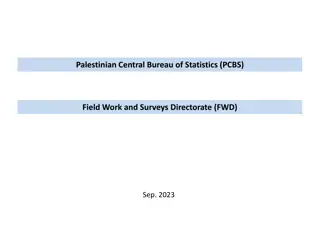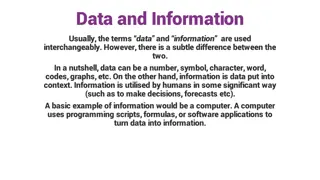Understanding the Importance of SDMX in Statistical Data Exchange
Statistical Data and Metadata Exchange (SDMX) is an ISO standard crucial for describing, exchanging, and sharing statistical data efficiently across organizations. SDMX automates SDG data exchange, facilitates validation and reporting, and emphasizes the significance of data models. Developing a Data Structure Definition (DSD) ensures proper data description in SDMX.
Download Presentation
Please find below an Image/Link to download the presentation.
The content on the website is provided AS IS for your information and personal use only. It may not be sold, licensed, or shared on other websites without obtaining consent from the author. Download presentation by click this link. If you encounter any issues during the download, it is possible that the publisher has removed the file from their server.
Presentation Transcript
SDMX Information Model Rabih El Habta First National Training on the Use of SDMX in SDG Reporting 28-30 August 2023
Statistical Data and Metadata Exchange (SDMX) What is SDMX? SDMX is an ISO standard designed to describe statistical data and metadata, normalize their exchange, and improve their efficient sharing across statistical and similar organizations. SDMX sets statistical and technical standardsto facilitate the exchange of statistical data and metadata using modern information technology. Why SDMX is important for SDGs? SDMX enables the automation of SDG data and metadata exchange between two or more entities. SDMX also facilitates the validation, dissemination, and reporting of SDG data. 2
Figures vs data Number of touristic establishments in Italy, annual data Italy Annual data Number of touristic establishments Number of touristic establishments Number of touristic establishments Number Number of touristic establishments Number of touristic establishments Number of touristic establishments Tourism establishments in Italy, annual data in Italy, annual data in Italy, annual data in Italy, annual data in Italy, annual data in Italy, annual data Figures by themselves are meaningless. For data to be usable, it must be properly described. The descriptions let users know what the data actually represents. Indicator Indicator Indicator Indicator Indicator Indicator Indicator A100 A100 A100 A100 A100 A100 A100 B010 B010 B010 B010 B010 B010 B010 B020 B020 B020 B020 B020 B020 B020 Time Time Time Time Time Time Time Hotels and similar Hotels and similar Hotels and similar Hotels and similar Hotels and similar Hotels and similar Hotels and similar Tourist Campsites Tourist Campsites Tourist Campsites Tourist Campsites Tourist Campsites Tourist Campsites Tourist Campsites Holiday dwellings Holiday dwellings Holiday dwellings Holiday dwellings Holiday dwellings Holiday dwellings Holiday dwellings 2002A00 2002A00 2002A00 2002A00 2002A00 2002A00 2002A00 33411 33411 33411 33411 33411 33411 33411 2374 2374 2374 2374 2374 2374 2374 61479 61479 61479 61479 61479 61479 61479 2003A00 2003A00 2003A00 2003A00 2003A00 2003A00 2003A00 33480 33480 33480 33480 33480 33480 33480 2530 2530 2530 2530 2530 2530 2530 58526 58526 58526 58526 58526 58526 58526 2529 2529 2529 2529 2529 2529 2004A00 2004A00 2004A00 2004A00 2004A00 2004A00 2004A00 33518 33518 33518 33518 33518 33518 33518 56586 56586 56586 56586 56586 56586 56586 2529 2529 2005A00 2005A00 2005A00 2005A00 2005A00 2005A00 2005A00 33527 33527 33527 33527 33527 33527 33527 2411 2411 2411 2411 2411 2411 2411 68385 68385 68385 68385 68385 68385 68385 2006A00 2006A00 2006A00 2006A00 2006A00 2006A00 2006A00 33768 33768 33768 33768 33768 33768 33768 2510 2510 2510 2510 2510 2510 2510 68376 68376 68376 68376 68376 68376 68376 2007A00 2007A00 2007A00 2007A00 2007A00 2007A00 2007A00 34058 34058 34058 34058 34058 34058 34058 2587 2587 2587 2587 2587 2587 2587 61810 61810 61810 61810 61810 61810 61810 3
Developing a Data Model for Data Exchange Data model is developed to provide descriptions for all relevant characteristics of the data to be exchanged In SDMX, data model is represented by a Data Structure Definition (DSD). To design a DSD, we first need to find concepts that identify and describe our data. 4
Concept Unit of thought created by a unique combination of characteristics * Each concept describes something about the data. Concepts should express all relevant data characteristics. * Source: SDMX Glossary 5
Identifying Concepts Indicator Time Period Ref. Area Unit Multiplier Obs. Value 6
SDMX Concept Scheme Set of Concepts that are used in a Data Structure Definition or Metadata Structure Definition. * Concept scheme places concepts into a maintainable unit. Concept name Concept ID Indicator INDICATOR Reference area REF_AREA Time period TIME_PERIOD Unit multiplier UNIT_MULT Observation value OBS_VALUE * Source: SDMX Glossary 7
Dimension Which of the concepts are used to identify an observation? Indicator Reference area Time Period When all 3 are known, we can unambiguously locate an observation in the table. These are called dimensions. A dimension is similar in meaning to a database table s primary key field. 8
Attribute In our example, Unit Multiplier represents additional information about observations. This concept is not used to identify a series or observation. Such concepts are called attributes. Not to be confused with XML attributes! Similar to a database table s non-primary key fields. 9
Primary Measure Observation Value represents a concept that describes the actual values being transmitted. In SDMX, such a concept is called Primary Measure. Primary Measure is usually represented by concept with ID OBS_VALUE. 10
Dimension or Attribute? Choosing the role of a concept has profound implications on the structure of data. Concepts that identify data, should be made dimensions. Concepts that provide additional information about data, should be made attributes. If a concept is a dimension, it is possible to have time series that are different only in the value of this concept. E.g. if Unit of Measure is a dimension, it is possible to have separate time series for T and T/HA or, more controversially, KG and T 11
Dimension or Attribute? (2) Cambodia Fixed and Mobile telephone subscriptions 2013 20.6 million Fixed and Mobile telephone subscriptions 2012 19.7 million Fixed and Mobile telephone subscriptions 2013 140.9 per 100 pop. Unit of measure as a dimension (dimensions underlined) Ref.Area Indicator Time Period Unit Unit Mult. Obs. Value Cambodia Fixed and Mobile telephone subscriptions 2013 Number Millions 20.6 Cambodia Fixed and Mobile telephone subscriptions 2012 Number Millions 19.7 Cambodia Fixed and Mobile telephone subscriptions 2013 Per 100 pop. Units 140.9 12
Dimension or Attribute? (3) Unit of measure as an attribute Violation! Ref.Area Indicator Time Period Unit Unit Mult. Obs. Value Cambodia Fixed and Mobile telephone subscriptions 2013 Number Millions 20.6 Cambodia Fixed and Mobile telephone subscriptions 2012 Number Millions 19.7 Cambodia Fixed and Mobile telephone subscriptions 2013 Per 100 pop. Units 140.9 The dataset above is invalid: duplicate observation The two values above are only different in their attributes 13
Dimension or Attribute? (4) Unit of measure as an attribute Ref.Area Indicator Time Period Unit Unit Mult. Obs. Value Cambodia Fixed and Mobile telephone subscriptions 2013 Number Millions 20.6 Cambodia Fixed and Mobile telephone subscriptions 2012 Number Millions 19.7 Cambodia Fixed and Mobile telephone subscriptions per 100 population 2013 Per 100 pop. Units 140.9 Now there is no violation because every row has a unique key The Unit concept is still useful 14
Attribute attachment In SDMX 2.0, attributes can be attached at observation, time series, group, or dataset level. In SDMX 2.1, attributes can be attached at observation, dimension(s), group, or dataset. When an attribute is attached to all dimensions except time, it is effectively attached to time series For practical purposes attributes are often attached at observation or time series. In addition, attributes can be designated as mandatory or conditional (optional). Mandatory attributes must be present at their attachment level for the dataset to be valid, while conditional attributes may be skipped. Dimensions, by contrast, must always be provided. 15
Cross-domain Concepts SDMX Statistical Working Group (SWG) develops and publishes Cross-Domain Concepts These are recommended concept IDs that are shared among statistical subject-matter domains and can be reused in many DSDs. The full list of cross-domain concepts is available at the SDMX web site under Guidelines: https://sdmx.org/?page_id=3215 The cross-domain concept scheme is also published at the SDMX Global Registry: https://registry.sdmx.org 16
Cross-domain Concepts: examples Some of the widely used cross-domain concepts include: Statistical indicator: INDICATOR Reference area: REF_AREA Sex: SEX Age: AGE Unit of measure: UNIT_MEASURE Unit multiplier: UNIT_MULT Time period: TIME_PERIOD Observation value: OBS_VALUE 17
Data model so far... Concept ID Role Attachment Indicator INDICATOR Dimension Reference area REF_AREA Dimension Time period TIME_PERIOD Dimension Unit multiplier UNIT_MULT Attribute Time series Observation value OBS_VALUE P.Measure 18
Representation DSD defines a range of valid values for each concept. When data are transferred, each of its descriptor concepts must have valid values. A concept can be Coded Un-coded with format Un-coded free text 19
Code A language-independent set of letters, numbers or symbols that represent a concept whose meaning is described in a natural language. A sequence of characters that can be associated with descriptions in any number of languages. Descriptions can be updated without disrupting mappings or other components of data exchange. 20
Code List A predefined list from which some statistical coded concepts take their values. A code list is a collection of codes maintained as a unit. A code list enumerates all possible values for a concept or set of concepts Sex code list Country code list Indicator code list, etc 21
Code List: Some Examples CL_SERIES CL_AREA CL_EDUCATION_LEV 22
SDMX Concepts and Code lists Code lists provide a representation for concepts, in terms of Codes. Codes are language-independent and may include descriptions in multiple languages. Code lists must be harmonized among all data providers that will be involved in exchange. 23
Un-coded Concepts Can be free-text: Any valid text can be used as a value for the concept. Footnote Can have their format specified Postal code: 5 digits Last update: date/time 24
Representation of concepts in SDMX Dimensions must be either coded or have their format specified. Free text is not allowed. Attributes can be coded or un-coded; format may optionally be specified. 25
Data model so far Concept ID Role Attachment Representation Indicator INDICATOR Dimension CL_INDICATOR Reference area REF_AREA Dimension CL_AREA Time period TIME_PERIOD Dimension Date/time (YYYY) Unit multiplier UNIT_MULT Attribute Time series CL_UNIT_MULT Observation value OBS_VALUE Pr. Measure Floating point number 26
Cross-domain Code Lists Similar to cross-domain concepts, SDMX Statistical Working Group (SWG) develops and publishes Cross-Domain Code Lists. When available, these are based on existing statistical classifications and contain codes from those classifications. Otherwise, codes are developed by the SWG. These codes should be used whenever possible in SDMX exchange or dissemination. The code lists are often extended with country or organization-specific codes. For example, the global Reference Area code list is often extended with subnational reference area codes for national data dissemination. 27
Cross-domain Concepts and Code Lists: examples Reference area: REF_AREA CL_AREA Sex: SEX CL_SEX Unit multiplier: UNIT_MULT CL_UNIT_MULT 28
Generic cross-domain codes Recommended Code Value Recommended Code Description _L Local extension (can be used as a prefix) _N Non response _O Other _S Subtotal _T Total _U No data/unknown _X Not allocated/unspecified _Z Not applicable These codes are recommended to be used in all code lists as appropriate. * Source: Guidelines for the creation and Management of SDMX Code Lists 29
Data model so far: Code Lists CL_INDICATOR Code Name CL_AREA (partial) POP Total Mid-Year Population Code Name AF Afghanistan CL_UNIT_MULT AL Albania Code Name AQ Antarctica 0 Units DZ Algeria 1 Tens AS American Samoa 2 Hundreds AD Andorra 3 Thousands 6 Millions 9 Billions 30
Data Structure Definition: summary Reference Reference Code lists Concept Scheme DSD Concept Concept ID Role Attachment Representation Code list ID Indicator INDICATOR Dimension Code List CL_INDICATOR Reference area REF_AREA Dimension Code List CL_AREA Time period TIME_PERIOD Dimension YYYY Unit multiplier UNIT_MULT Attribute Time series Code List CL_UNIT_MULT Obs. value OBS_VALUE Pr. Measure Floating point number 31
SDMX Artefacts While there are many types of artefacts, in almost all situations SDMX Artefact refers to a maintainable and versionable component of structural metadata. Concept Scheme DSD Code List Note that e.g. an individual Code is not an artefact, since it can only exist and be transmitted as part of a Code List. 32
SDMX Artefact Identification and Versioning Identification of SDMX Artefact consists of 3 fields: ID; Maintenance Agency; Version Type Name ID Maintenance Agency Version DSD NA Main Aggregates NA_MAIN ESTAT 1.11 DSD NA Main Aggregates NA_MAIN ESTAT 1.10 Concept Scheme SDG Concept Scheme SDG_CONCEPTS IAEG-SDGs 1.0 Code List Reference area code list CL_AREA SDMX 2.0 33
THANK YOU 34



